Approaching objects cause confusion in patients with Alzheimer's disease regarding their direction of self-movement
- PMID: 20647265
- PMCID: PMC2948814
- DOI: 10.1093/brain/awq140
Approaching objects cause confusion in patients with Alzheimer's disease regarding their direction of self-movement
Abstract
Navigation requires real-time heading estimation based-on self-movement cues from optic flow and object motion. We presented a simulated heading discrimination task to young, middle-aged and older adult, normal, control subjects and to patients with mild cognitive impairment or Alzheimer's disease. Age-related decline and neurodegenerative disease effects were evident on a battery of neuropsychological and visual motion psychophysical measures. All subject groups made more accurate heading judgements when using optic flow patterns than when using simulated movement past earth-fixed objects. When both optic flow and congruent object were presented together, heading judgements showed intermediate accuracy. In separate trials, we combined optic flow with non-congruent object motion, simulating an independently moving object. In the case of non-congruent objects, almost all of our subjects shifted their perceived self-movement to heading in the direction of the moving object. However, patients with Alzheimer's disease uniquely indicated that perceived self-movement was straight-ahead, in the direction of visual fixation. The tendency to be confused by objects that appear to move independently in the simulated visual scene corresponded to the difficulty patients with Alzheimer's disease encountered in real-world navigation through the hospital lobby (R(2) = 0.87). This was not the case in older normal controls (R(2) = 0.09). We conclude that perceptual factors limit safe, autonomous navigation in early Alzheimer's disease. In particular, the presence of independently moving objects in naturalistic environments limits the capacity of patients with Alzheimer's disease to judge their heading of self-movement.
Figures
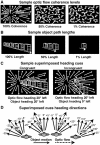
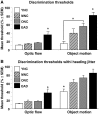
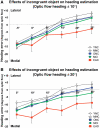
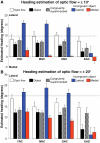
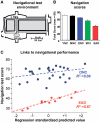
Similar articles
-
Multisensory Integration of Visual and Vestibular Signals Improves Heading Discrimination in the Presence of a Moving Object.J Neurosci. 2015 Oct 7;35(40):13599-607. doi: 10.1523/JNEUROSCI.2267-15.2015. J Neurosci. 2015. PMID: 26446214 Free PMC article.
-
Cue integration for the perception and control of self-movement in ageing and Alzheimer's disease.Brain. 2006 Nov;129(Pt 11):2931-44. doi: 10.1093/brain/awl201. Brain. 2006. PMID: 17071922
-
Cortical area MSTd combines visual cues to represent 3-D self-movement.Cereb Cortex. 2006 Oct;16(10):1494-507. doi: 10.1093/cercor/bhj082. Epub 2005 Dec 7. Cereb Cortex. 2006. PMID: 16339087
-
Visual and vestibular cue integration for heading perception in extrastriate visual cortex.J Physiol. 2011 Feb 15;589(Pt 4):825-33. doi: 10.1113/jphysiol.2010.194720. Epub 2010 Aug 2. J Physiol. 2011. PMID: 20679353 Free PMC article. Review.
-
How Optic Flow and Inertial Cues Improve Motion Perception.Cold Spring Harb Symp Quant Biol. 2014;79:141-8. doi: 10.1101/sqb.2014.79.024638. Cold Spring Harb Symp Quant Biol. 2014. PMID: 26092884 Review.
Cited by
-
Perceiving Collision Impacts in Alzheimer's Disease: The Effect of Retinal Eccentricity on Optic Flow Deficits.Front Aging Neurosci. 2015 Nov 25;7:218. doi: 10.3389/fnagi.2015.00218. eCollection 2015. Front Aging Neurosci. 2015. PMID: 26635603 Free PMC article.
-
Multisensory visual-vestibular training improves visual heading estimation in younger and older adults.Front Aging Neurosci. 2022 Aug 25;14:816512. doi: 10.3389/fnagi.2022.816512. eCollection 2022. Front Aging Neurosci. 2022. PMID: 36092809 Free PMC article.
-
Causal inference accounts for heading perception in the presence of object motion.Proc Natl Acad Sci U S A. 2019 Apr 30;116(18):9060-9065. doi: 10.1073/pnas.1820373116. Epub 2019 Apr 17. Proc Natl Acad Sci U S A. 2019. PMID: 30996126 Free PMC article.
-
Might cortical hyper-responsiveness in aging contribute to Alzheimer's disease?PLoS One. 2014 Sep 10;9(9):e105962. doi: 10.1371/journal.pone.0105962. eCollection 2014. PLoS One. 2014. PMID: 25208332 Free PMC article.
-
Multisensory Integration of Visual and Vestibular Signals Improves Heading Discrimination in the Presence of a Moving Object.J Neurosci. 2015 Oct 7;35(40):13599-607. doi: 10.1523/JNEUROSCI.2267-15.2015. J Neurosci. 2015. PMID: 26446214 Free PMC article.
References
-
- Armstrong RA. Visual field defects in Alzheimer's disease patients may reflect differential pathology in the primary visual cortex. Optom Vis Sci. 1996;73:677–82. - PubMed
-
- Arnold SE, Hyman BT, Flory J, Damasio AR, Van Hoesen GW. The topographical and neuroanatomical distribution of neurofibrillary tangles and neuritic plaques in the cerebral cortex of patients with Alzheimer's disease. Cereb Cortex. 1991;1:103–16. - PubMed
-
- Baloh RW, Fife TD, Zwerling L, Socotch T, Jacobson K, Bell T, Beykirch K. Comparison of static and dynamic posturography in young and older normal people. J Am Geriatr Soc. 1994;42:405–12. - PubMed
-
- Benton A, Hamsher K, Varney NR, Spreen O. Contributions to neuropsychological assessment: a clinical manual. New York: Oxford University Press; 1983.
Publication types
MeSH terms
Grants and funding
LinkOut - more resources
Full Text Sources
Medical
Miscellaneous

